Harry O’Brien
Greg Purcell
N W E S STUDENT BOOK 6 MP_NSW_SB6_38350_TXT_4PP.indb 1 25-Aug-23 17:54:03
NEW SOUTH WALES SYLLABUS
SAMPLEPAGES
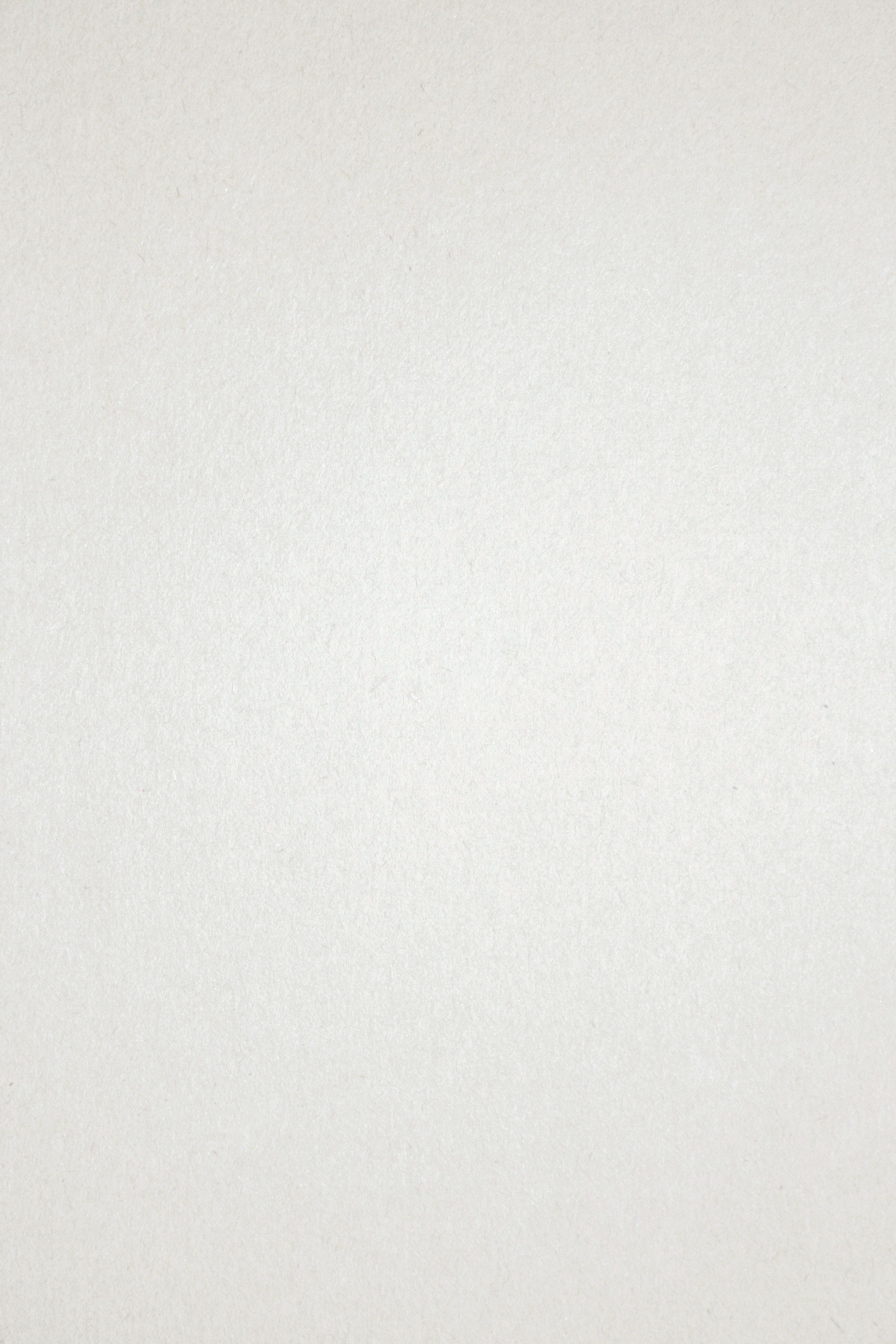

ii TERM 1 • Addition of 4-digit numbers/estimation 2 • Multiplication strategies 3 • Measuring angles 4 • Kilometres 5 • Addition and subtraction strategies 6 • Percentage, fractions and decimals 7 • Revising shapes 8 • Square centimetres and square metres 9 • Subtracting 4-digit numbers/problems 10 • Revising 3-digit division/problems 11 • Many to one scales/picture graphs 12 • Constructing angles 13 • Addition/distance by car 14 • Place value 15 • Negative numbers 16 • Classifying three-dimensional objects 17 • Revising multiplication/estimation 18 • Decimals, percentages and fractions 19 • Random selection/data sampling 20 • Estimating mass 21 • Division strategies/problems 22 • Number patterns 23 • Side-by-side column graphs 24 • am and pm revision 25 • Multiplication strategies/problems 26 • Comparing fractions/equivalence 27 • Probability/frequency 28 • Millimetres and centimetres 29 • Addition/checking using inverse operation 30 • Balance 31 • Perimeter 32 • Many to one scales/different data displays 33 • Division with fractional remainders 34 • Improper fractions and mixed numerals 35 • Grid references revision 36 • Chance experiment and column graphs 37 • Diagnostic review 1 38 TERM 2 • Geometric patterns 40 • Prime and composite numbers 41 • Triangles/angles 42 • Area of triangles 43 • Measures of quantities 44 • Decimals to thousandths 45 • Chance from zero to one 46 • Creating three-dimensional objects 47 • Adding decimals/money problems 48 • Decimals, percentages and fractions 49 • Line graphs 50 • Calculating volume 51 • Operations with decimals/problems 52 • Equivalent number sentences 53 • Constructing quadrilaterals 54 • 24-hour time/timetables/elapsed time 55 • Subtraction/problems 56 • Comparing and ordering fractions 57 • Drawing objects from views 58 • Metres, centimetres and millimetres 59 • 4-digit × 1-digit multiplication/problems 60 • Add and subtract fractions 61 • Potentially misleading data 62 • Area of parallelograms 63 • Extended multiplication/problems 64 • Expanding numbers 65 • Mass experiments 66 • Revising symmetry/rotational symmetry 67 • Order of operations 68 • Add and subtract fractions 69 • Describing chance 70 • Construct and draw 3D objects 71 • Subtracting decimals/money 72 • Geometric patterns/rules 73 • Measuring angles 74 • Volume and capacity 75 • Diagnostic review 2 76 1 unit 2 3 4 5 6 7 8 9 unit 10 11 12 13 14 15 16 17 18 Contents MP_NSW_SB6_38350_TXT_4PP.indb 2 25-Aug-23 17:54:04 SAMPLEPAGES


iii TERM 3 • Dividing 5-digit numbers/problems 78 • Percentages 79 • Decimal representations/perimeter 80 • Tonnes 81 • Square numbers 82 • Dividing by tens and finding averages 83 • Reflect, translate, rotate 84 • Different data displays/sector graphs 85 • Extended multiplication 86 • Subtracting fractions from whole numbers 87 • Computer graph making 88 • Decimal time units/elapsed time 89 • Geometric patterns 90 • Comparing fractions/equivalent fractions 91 • Coordinates 92 • Misleading data 93 • Multiplying decimals and money/problems 94 • Comparing fractions/equivalent fractions 95 • Quadrilaterals 96 • Coordinates 97 • Dividing large numbers/problems 98 • Add and subtract fractions with related denominators 99 • Adjacent angles 100 • Layers/the cubic centimetre 101 • Addition of 4-, 5- and 6-digit numbers 102 • Multiplication by tens/problems 103 • Reflect, translate, rotate and combine 104 • Data sampling 105 • Multiplication by 2 digits 106 • Negative numbers 107 • Rounding 108 • Sample data/survey 109 • Decimal remainders of quantities 110 • Recording division as fractions 111 • The Cartesian plane 112 • Hectares and square kilometres 113 • Diagnostic review 3 114 TERM 4 • Calculator/order of operations (brackets) 116 • Negative numbers 117 • Fractional quantities 118 • Timelines 119 • Multiplication by 2 digits/problems 120 • Finding percentages 121 • Word problems/multiplication and division 122 • Calculating volume 123 • Decimal number patterns 124 • Prime factors 125 • Choosing units and measuring devices 126 • Mean and mode 127 • Decimals × powers of ten 128 • Number patterns 129 • Rearranging shapes 130 • Comparing distances in kilometres 131 • Relative place value 132 • Measures of quantities 133 • Cartesian plane 134 • Mass units 135 • Decimal/fraction number patterns 136 • Order of operations 137 • Range and median 138 • Making a cubic metre 139 • Number patterns 140 • Generating whole quantities 141 • Intersecting lines 142 • Different displays 143 • Equivalent number sentences 144 • Chance/justifying a solution 145 • Negative numbers 146 • Bisecting shapes/diagonals 147 • Diagnostic review 4 148 Dictionary 150 Answers 157 19 unit 20 21 22 23 24 25 26 27 unit 28 29 30 31 32 33 34 35 MP_NSW_SB6_38350_TXT_4PP.indb 3 25-Aug-23 17:54:06 SAMPLEPAGES
The Maths Plus NSW Syllabus/Australian Curriculum series, Year K to Year 6, is based on the NSW Education Standards Authority 2023 Mathematics K-6 Syllabus for the Australian Curriculum Mathematics (ACARA). Each book after Year K builds upon prior knowledge and works towards an understanding of the achievement standards for the relevant year level and beyond. Maths Plus provides students with opportunities to sequentially develop their skills and knowledge in the strands of the Australian Curriculum Mathematics: Number, Algebra, Measurement, Space, Statistics and Probability



Series components
Student Books
Student Book features
• All pages are colour coded.
Number and Algebra
and Space
Statistics and Probability

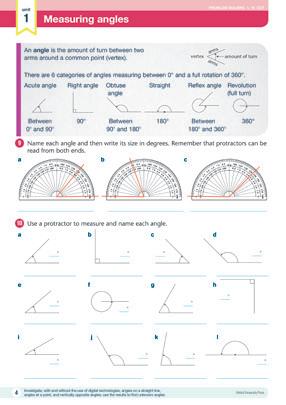
Work towards achieving the relevant outcomes by developing skills and competency in understanding mathematical structures, fluency, reasoning and problem solving.
Mentals and Homework Books

Provide concise, essential revision and consolidation activities that correspond with the concepts and units of work presented in the Student Books.
Assessment Books
Include short post-tests with a simple marking system to assess students’ skills and understanding of the concepts in the Student Books.
• Australian Curriculum Mathematics content descriptions, proficiency strand references and general capabilities appear on each page.
• The Dictionary (Years 2 to 6) features clear and simple explanations of mathematical terms and language.
Diagnostic term reviews
• Diagnostic term reviews (Years 1 to 6) assist in pinpointing students’ strengths and weaknesses, allowing intervention and re-teaching opportunities where required.
• The Find a topic page allows teachers the freedom to address particular topics and student needs as appropriate, providing essential revision and consolidation opportunities.
SAMPLEPAGES


Teacher Book and Teacher Dashboard


Provide access to a wealth of resources and support material:
• curricula and planning documents
• interactive teaching tools
• potential difficulties videos
• learning activities
• support and extension activities
• reflection
• blackline masters and investigation pages
• links to Advanced Primary Maths (Years 3 to 6)

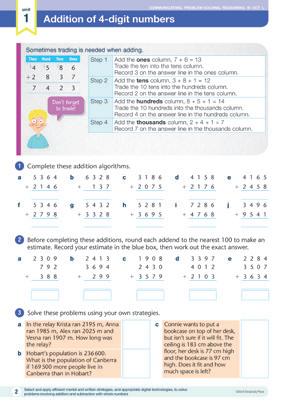

• assessment tests
• answers for student resources
www.oxfordowl.com.au
Oxford Owl is the home for Oxford Primary professional resources.
iv
a topic
Find
Measurement
Dictionary
To the teacher
MP_NSW_SB6_38350_TXT_4PP.indb 4 25-Aug-23 17:54:11
MEASUREMENT AND SPACE


v Find a topic NUMBER AND ALGEBRA Whole numbers Square numbers 82 Prime and composite numbers 41 Prime factors 125 Place value 15, 65, 132 Rounding/estimation 2, 18, 108 Positive and negative numbers (integers) 16, 107, 117, 146 Addition and subtraction Adding 2-, 3-, 4-, 5- 2, 6, 14, 30, 102 and 6-digit numbers Subtracting 2-, 3-, 4-, 5- 6, 10, 56 and 6-digit numbers Number sentences 31, 53, 144 Problems 10, 56 Multiplication and division Order of operations 68, 137, 116 Multiplication of 2-, 3- and 3, 18, 26, 60 4-digit numbers Multiplying by tens 103 Extended multiplication 64, 86, 106, 120 Division of 3-, 4- 11, 22, 34, 78, 83, 98, 122 and 5-digit numbers Equivalent number sentences 31, 53, 144 Mean scores 127 Recording division as a fraction 111 Problems 11, 22, 26, 103, 122 Fractions and decimals Common fractions 7, 19, 49, 57 Comparing fractions/equivalent fractions 27, 91, 95, 99, 133 Measures of quantities 44, 118, 131, 141 Adding and subtracting fractions 61, 69, 87, 99 Improper fractions 35 Mixed numerals 35, 57 Decimals 7, 19, 45, 49 Adding and subtracting decimals 48, 52, 72 Multiplying and dividing decimals 94, 128 Percentages 7, 19, 49, 79, 121 Decimal remainders 110 Problems 48, 52 Patterns and algebra Geometric patterns 40, 73, 90 Number patterns 23, 82, 124, 129, 136, 140 Number sentences/balance 31, 53, 144 Order of operations 68, 137, 116 STATISTICS AND PROBABILITY Data Column graphs + side by side 24, 37, 143 Many to one scales/picture graphs 12 Different data displays/sector graphs 85 Line graph 50 Many to one scales/different data displays 33 Data investigations 109 Mean 127 Median 138 Mode 127 Secondary data/misleading data 62, 93 Random selection/data sampling 20, 105 Computer graph making 88 Timelines 119 Chance Chance 28, 37, 46, 70, 145 Sample data 105, 109 Probability/frequencies 28 Random selection/data sampling 20, 105 page page
Length Centimetres 29, 59 Metres 59 Millimetres 29, 59 Perimeter 32, 80 Kilometres 5, 131 Choosing units 126 Area Square centimetres 9 Square metres 9 Hectares 113 Square kilometres 113 Area of triangles 43 Area of parallelograms 63 Mass Kilograms 21, 81, 135 Grams 21, 135 Tonnes 81, 135 Mass and capacity 66 Volume and capacity Litres 66, 75 Millilitres 66, 75 Cubic centimetres 51, 75, 101, 123 Cubic metres 139 Displacement 75 Relationships 66, 75 Time Converting units 25 24-hour time 55 Elapsed time 89 Timetables 55, 89 Timelines 119 am and pm notation 25 Three-dimensional space Names and properties 17, 58 Top, front and side views 58 Construct and draw 3D objects 47, 58, 71 Two-dimensional space Names and properties 8 Revising symmetry and rotational symmetry 67 Triangles 42 Drawing 2D shapes 32, 54, 130 Rearranging shapes/bisecting shapes 130, 147 Quadrilaterals 54, 96 Translations 84, 104 Angles Measuring angles 4, 74 Constructing angles 13 Triangles/angles 42 Adjacent angles 100 Vertically opposite angles 74, 100 Intersecting lines 74, 100, 142 Cartesian plane Revising grid references 36 Coordinates, Cartesian plane 92, 97, 112, 134 MP_NSW_SB6_38350_TXT_4PP.indb 5 25-Aug-23 17:54:11 SAMPLEPAGES
NSW Syllabus Outcomes
MA3-RN-01
Applies an understanding of place value and the role of zero to represent the properties of numbers
MA3-RN-02
Compares and orders decimals up to 3 decimal places
MA3-RN-03
Determines percentages of quantities, and finds equivalent fractions and decimals for benchmark percentage values
MA3-AR-01
Selects and applies appropriate strategies to solve addition and subtraction problems
MA3-MR-01
Selects and applies appropriate strategies to solve multiplication and division problems
MA3-MR-02
Constructs and completes number sentences involving multiplicative relations, applying the order of operations to calculations
MA3-RQF-01
Compares and orders fractions with denominators of 2, 3, 4, 5, 6, 8 and 10
MA3-RQF-02
Determines
MA3-GM-01
Locates and describes points on a coordinate plane
MA3-GM-02
MA3-GM-03
of measures and quantities
MEASUREMENT AND SPACE
Selects and uses the appropriate unit and device to measure lengths and distances including perimeters
Measures and constructs angles, and identifies the relationships between angles on a straight line and angles at a point
MA3-2DS-01
Investigates and classifies two-dimensional shapes, including triangles and quadrilaterals based on their properties
MA3-2DS-02
Selects and uses the appropriate unit to calculate areas, including areas of rectangles
MA3-2DS-03
Combines, splits and rearranges shapes to determine the area of parallelograms and triangles
MA3-3DS-01
Visualises, sketches and constructs three-dimensional objects, including prisms and pyramids, making connections to two-dimensional representations
MA3-3DS-02
Selects and uses the appropriate unit to estimate, measure and calculate volumes and capacities
MA3-NSM-01
Selects and uses the appropriate unit and device to measure the masses of objects
SAMPLEPAGES


MA3-NSM-02
Measures and compares duration, using 12- and 24-hour time and am and pm notation
MA3-DATA-01
Constructs graphs using many-to-one scales
MA3-DATA-02
Interprets data displays, including timelines and line graphs
MA3-CHAN-01
Conducts chance experiments and quantifies the probability
MAO-WM-01 Working mathematically
STATISTICS AND PROBABILITY
Develops understanding and fluency in mathematics through exploring and connecting mathematical concepts, choosing and applying mathematical techniques to solve problems, and communicating their thinking and reasoning coherently and clearly
vi
Units 1 2 3 4
NUMBER AND ALGEBRA
1 4
1 5
1
1 2 ,
,
and
10
MP_NSW_SB6_38350_TXT_4PP.indb 6 25-Aug-23 17:54:11
MA3-NSM-02


MA3-DATA-01
MA3-DATA-02
MA3-CHAN-01
MAO-WM-01 Working mathematically
STATISTICS AND PROBABILITY
vii 5 6 7 8 9 10 11 12 13 14 15 16 17 18 19 20 21 22 23 24 25 26 27 28 29 30 31 32 33 34 35 NUMBER AND ALGEBRA
AND SPACE
MA3-RN-01 MA3-RN-02 MA3-RN-03 MA3-AR-01 MA3-MR-01 MA3-MR-02 MA3-RQF-01 MA3-RQF-02 MEASUREMENT
MA3-GM-01 MA3-GM-02 MA3-GM-03 MA3-2DS-01 MA3-2DS-02 MA3-2DS-03 MA3-3DS-01 MA3-3DS-02 MA3-NSM-01
MP_NSW_SB6_38350_TXT_4PP.indb 7 25-Aug-23 17:54:11
SAMPLEPAGES
Addition of 4-digit numbers/estimation
Step 1 Add the ones column, 7 + 6 = 13
Trade the ten into the tens column. Record 3 on the answer line in the ones column.
Step 2 Add the tens column, 3 + 8 + 1 = 12
Trade the 10 tens into the hundreds column. Record 2 on the answer line in the tens column.
Step 3 Add the hundreds column, 8 + 5 + 1 = 14
Trade the 10 hundreds into the thousands column. Record 4 on the answer line in the hundreds column.
Step 4 Add the thousands column, 2 + 4 + 1 = 7
Record 7 on the answer line in the thousands column.
Complete these addition algorithms.
SAMPLEPAGES

Before completing these additions, round each addend to the nearest 100 to make an estimate. Record your estimate in the blue box, then work out the exact answer.

Solve these problems using your own strategies.
a In the relay, Krista ran 2195 m, Anna ran 1985 m, Alex ran 2025 m and Vesna ran 1907 m. How long was the relay?
b Hobart’s population is 236 600. What is the population of Canberra if 169 500 more people live in Canberra than in Hobart?
c Connie wants to put a bookcase on top of her desk, but isn’t sure if it will fit. The ceiling is 183 cm above the floor, her desk is 77 cm high and the bookcase is 97 cm high. Does it fit and how much space is left?
1 unit 2 Selects and applies appropriate strategies to solve addition and subtraction problems COMMUNICATING, PROBLEM SOLVING, REASONING N CCT L
a 4 b 6 3 2 8 c 3 1 8 6 d 4 1 5 8 e 4 1 6 5 + 2 1 4 6 + 1 3 7 + 2 0 7 5 + 2 1 7 6 + 2 4 5 8 f 5 3 4 6 g 5 4 3 2 h 5 2 8 1 i 7 2 8 6 j 3 4 9 6 + 2 7 9 8 + 3 3 2 8 + 3 6 9 5 + 4 7 6 8 + 9 5 4 1
a 2 3 0 9 b 2 4 1 3 c 1 9 0 8 d 3 3 9 7 e 2 2 8 4 7 9 2 3 6 9 4 2 4 3 0 4 0 1 2 3 5 0 7 + 3 8 8 + 2 9 9 + 3 5 7 9 + 2 1 0 3 + 3 6 3 4
1 2 3
Sometimes trading is needed when adding. Thou Hund Tens Ones 14 15 18 6 + 2 8 3 7 7 4 2 3 Don’t forget to trade! Oxford University Press MP_NSW_SB6_38350_TXT_4PP.indb 2 25-Aug-23 17:54:12
Use your knowledge of number facts to answer these questions.
Multiply by 10, then halve to multiply by 5.

Use the ‘double, then double again’ strategy to multiply by 4. Or use the ‘double, double, double’ strategy to multiply by 8.

Round to the nearest 10 or 100 to make an estimate of these multiplications.

1 unit 3 N Selects and applies appropriate strategies to solve multiplication and division problems Multiplication strategies Complete the multiplication grid. × 4 6 5 0 7 10 9 3 8 1 3 4 5 6 7 8 9
a 4 × 5 = f 40 × 3 = k 20 × 9 = p 300 × 4 = b 40 × 5 = g 50 × 7 = l 30 × 9 = q 400 × 5 = c 6 × 7 = h 70 × 5 = m 40 × 7 = r 600 × 6 = d 60 × 7 = i 60 × 3 = n 50 × 8 = s 800 × 8 = e 30 × 8 = j 90 × 2 = o 60 × 6 = t 900 × 7 =
a 12 × 5 = d 18 × 5 = g 36 × 5 = j 42 × 5 = b 14 × 5 = e 20 × 5 = h 48 × 5 = k 44 × 5 = c 16 × 5 = f 24 × 5 = i 38 × 5 = l 50 × 5 =
a 12 × 4 = f 33 × 4
k 13 × 8 =
15 × 4 = g 45 × 4
l 14 × 8 = c 16 × 4 = h 8 ×
m 23 × 8 = d 22 × 4 = i 12 ×
= n 32 × 8 = e 18 × 4 = j 16 ×
= o 17 × 8 =
=
b
=
8 =
8
8
a 19 × 3 ≈ d 31 × 6 ≈ g 57 × 5 ≈ j 199 × 5 ≈ b 22 × 4 ≈ e 18 × 7 ≈ h 39 × 6 ≈ k 302 × 6 ≈ c 28 × 5 ≈ f 23 × 8 ≈ i 42 × 4 ≈ l 204 × 7 ≈ 4 5 6 7 8 Learn any facts you don’t
4 × 3 = 12 so 40 × 3 = 120. 23 × 4 = ? Think double 23 = 46. Double 46 = 92. Oxford University Press MP_NSW_SB6_38350_TXT_4PP.indb 3 25-Aug-23 17:54:14 SAMPLEPAGES
know.
Measuring angles
An angle is the amount of turn between two arms around a common point (vertex). vertex arm arm amount of turn
There are 6 categories of angles measuring between 0° and a full rotation of 360°.
Acute angle Right angle Obtuse Straight Reflex angle Revolution angle (full turn) Between 90° Between 180° Between 360° 0° and 90° 90° and 180° 180° and 360°
Name each angle and then write its size in degrees. Remember that protractors can be read from both ends.
Use a protractor to measure and name each angle.



SAMPLEPAGES

unit 4 PROBLEM SOLVING Measure
angles, and identify the relationships between angles on a straight line and angles at a point
and construct
a b c
a b c d ° ° ° ° e f g h ° ° ° ° i j k l ° ° ° ° 9 10 1 Oxford University Press MP_NSW_SB6_38350_TXT_4PP.indb 4 25-Aug-23 17:54:16
Longer distances are measured in kilometres. There are 1000 m in 1 kilometre.
SAMPLEPAGES
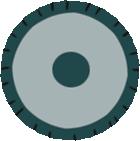



km km km km km
f Kedron km
g Coopers Plain km
h Hamilton km
i Mt Gravatt km
j Woolloongabba km
k Graceville km
Record these distances in kilometres using decimal notation. a 9154 metres = 9.154 km
Sheree keeps a log book of all her work trips. On the left is the odometer reading at the start of her day. Show the odometer reading at the end of the day if she made three trips.
Oxford University Press 5 unit Kilometres UNDERSTANDING, FLUENCY N CCT Selects and uses the appropriate unit and device to
lengths and distances
perimeters 1
measure
including
e
c
f
20 40 60 80 100 120 140 160 180 200 220 240 3 2 5 6 7 4
d 10 956 metres = b 6729 metres =
15 638 metres =
7935 metres =
19 006 metres =
Indooroopilly Coopers Plain Robertson Nathan Banoon Macgregor Mackenzie Mans eld Belmont Carindale Como Hill Graceville Mt Gravatt 13 14
Odometer:
Trip 1 14.25 km Trip 2 36.35 km
Trip 3 24.4 km
MP_NSW_SB6_38350_TXT_4PP.indb 5 25-Aug-23 17:54:16
Addition and subtraction strategies
Add these numbers mentally.
Give an estimate for each question by rounding each number. The first one has been done for you.
Subtract these numbers
7 Estimate first, then solve the problems mentally.
SAMPLEPAGES
a Joseph had 155 sheep in one paddock and 38 sheep in another. How many sheep did he have altogether?

b Marina had 379 g of flour and 122 g of sugar. If she mixed them together, how much would the mixture weigh?
c Jessica had a collection of 156 hair clips but sold 39 of them. How many hair clips does she have left?

d Sai travelled 1106 km on Tuesday and 488 km on Wednesday. How far has he travelled altogether?
e Uncle Sam’s Car Sales had 173 vehicles in the lot. If 58 of them were damaged by hail, how many were not damaged?
unit 6
PROBLEM SOLVING, REASONING N Selects and applies appropriate strategies to solve addition and subtraction problems 2
a 64 + 29 = f 156 + 19 = k 128 + 67 = b 135 + 38 = g 127 + 37 = l 347 + 47 = c 163 + 29 = h 229 + 48 = m 675 + 29 = d 135 + 28 = i 333 + 29 = n 876 + 37 = e 237 + 49 = j 247 + 38 = o 293 + 58 =
a 212 + 397 ≈ 600 g 354 + 146 ≈ m 1379 + 222 b 316 + 484 ≈ h 245 + 360 ≈ n 1498 + 307 c 309 + 201 ≈ i 739 + 555 ≈ o 1689 + 221 d 678 + 320 ≈ j 347 + 563 ≈ p 2365 + 437 e 476 + 281 ≈ k 797 + 707 ≈ q 5290 + 615 f 979 + 219 ≈ l 369 + 432 ≈ r 309 + 2388
mentally. a 75 39 = f 193 49 = k 187 38 = b 87 48 = g 292 38 = l 297 27 = c 93 49 = h 156 27 = m 356 49 = d 87 58 = i 194 29 = n 275 37 = e 86 37 = j 176 39 = o 196 29 =
Problem Estimate
1 2 3 4 67 + 28?
67 + 30 minus 2, 97 – 2 =
64 – 38?
64 – 40 plus 2. Oxford University Press MP_NSW_SB6_38350_TXT_4PP.indb 6 25-Aug-23 17:54:18
Think
95.
Think
Percentages, fractions and decimals
A percentage is another way of recording a fraction with a denominator of 100. Per cent means ‘out of 100’. A percentage sign % is used to display percentages. EXAMPLE 85 100 can be written as 85%.
SAMPLEPAGES

Compares and order decimals up to 3 decimal places
Determine percentages of quantities, and find equivalent fractions and decimals for benchmark percentage values
unit 7 PROBLEM SOLVING N
2
c 1 4 100 0. % i 3 4 % d 3 10 100 0. % j 0.8 % e 4 10 100 0. % k 90% f 1 2 100 0. % l 1 % Write each fraction or decimal as a percentage a 36 100 % c 99 100 % e 0.5 % g 7 10 % b 0.74 % d 0.67 % f 1 10 % h 0.9 % 7
Oxford University Press MP_NSW_SB6_38350_TXT_4PP.indb 7 25-Aug-23 17:54:18
Revising shapes 2
Name each shape, then record the number of sides and angles on each.
Which shapes above are parallelograms?
Draw an example of each shape. The 5 mm dot paper may help you.
What am I? I am not a square but I have 4 sides of equal length and my opposite angles are equal.
Investigate and classify two-dimensional shapes, including triangles and quadrilaterals based on their properties
unit 8 UNDERSTANDING CCT
Shape Name Sides Angles Shape Name Sides Angles a e b f c g
h
d
Triangle
e Octagon f Pentagon g Rhombus h Trapezium
a Square b Rectangle c
d Hexagon
8 9 10 11 MP_NSW_SB6_38350_TXT_4PP.indb 8 25-Aug-23 17:54:19
SAMPLEPAGES
Square centimetres and square metres 2

The formula used to calculate the area of a rectangle is Area = length × width. Width Length
Break these shapes into rectangles in order to work out their area. The first one has been done for you.
Selects and use the appropriate unit to calculate areas, including areas of rectangles
99
unit PROBLEM SOLVING CCT N
b × m2 c × m2 7.2 m 6.3 m 2 m 2 m 3 m b a c
Oxford University Press
a b c 4 cm 2 cm 2 cm 3 cm 2 cm 5 cm 4 cm 2 cm 2 cm 1 cm 1 cm 4 cm 3 cm 2 cm 3 cm 2 cm a A = (4 cm × 3 cm) + (3 cm × 2 cm) b A = ( × ) + ( × ) c A = ( × ) + ( × ) = 12 cm2 + 6 cm2 = = = 18 cm2 = cm2 = cm2 14 MP_NSW_SB6_38350_TXT_4PP.indb 9 25-Aug-23 17:54:19
SAMPLEPAGES
Subtracting 4-digit numbers/problems
Step 1 7 from 6 can’t do. Trade a 10 from the tens column. There are now 7 tens in the tens column and 16 ones in the ones column. 16 7 = 9
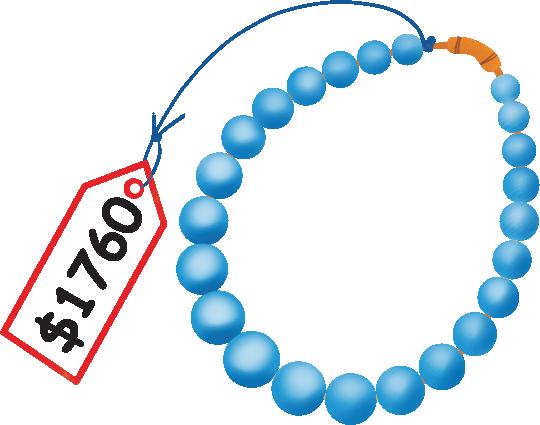
Record 9 on the answer line in the ones column.
Step 2 5 tens from 7 tens = 2 tens

Record 2 on the answer line in the tens column.
Step 3 9 hundreds from 4 hundreds can’t do. Trade 1000 from the thousands column.

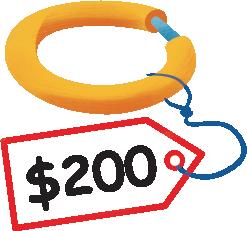
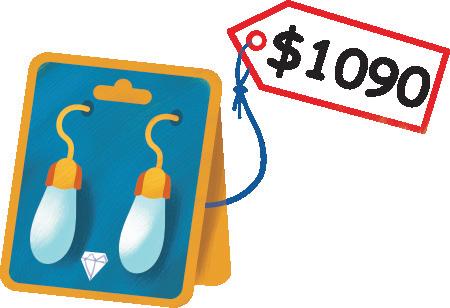

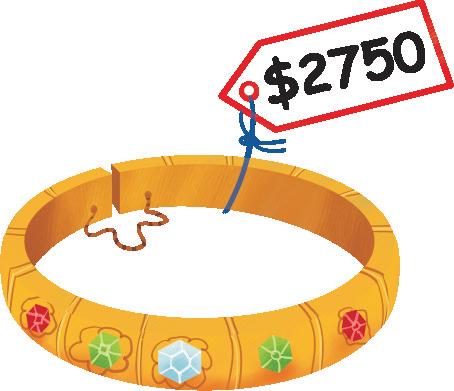
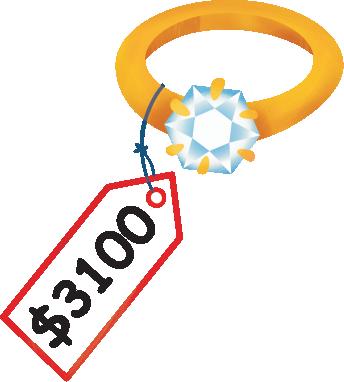
There are now 5 thousands in the thousands column and 14 hundreds in the hundreds column. 14 9 = 5
Record 5 on the answer line in the hundreds column.
Step 4 2 thousands from 5 thousands = 3 thousands.
Record 3 on the answer line in the thousands column.

unit 10 COMMUNICATING, PROBLEM SOLVING L Selects and applies appropriate strategies to solve addition and subtraction problems
Oxford University Press
3
Sometimes trading is needed
Thous Hund Tens Ones 56 14 78 16 – 2 9 5 7 3 5 2 9
when subtracting.
a 4 7 0 6 b 8 0 3 4 c 8 6 6 6 d 7 5 0 3 e 7 7 7 7 2 3 0 0 7 0 0 0 6 5 8 2 9 8 6 4 6 0 0 f 5 6 3 0 g 8 5 7 0 h 7 4 0 0 i 8 5 0 0 j 7 0 0 0 4 6 7 2 3 6 5 4 8 7 0 0 4 6 0 3 8
1 Complete each algorithm.
a 5 8 7 b 8 7 6 3 c 5 1 4 d 7 9 8 e 9 5 1 2 5 9 4 0 3 5 2 7 5 8 3 6 7 2 3 5 1 7 6 3 5 5 6 3 7 7 5 2 8 5 6
the profit
cost
Ring
Selling price Cost price $2385 $1986 $898 $395 $809 $157 $48 Profit 1 2 3 Don’t forget to trade! MP_NSW_SB6_38350_TXT_4PP.indb 10 25-Aug-23 17:54:21 SAMPLEPAGES
2 Fill in the empty boxes to complete these algorithms.
Calculate
made on each item by comparing the
price and the selling price.
Bracelet Necklace Watch Earrings Nose ring Locket
Trade the 2 hundreds left for 20 tens. Now share the 26 tens. Each school gets 5. 1 5 | 7 6 7 1 5 5 | 726 7 1 5 3r2 5 | 72617

Trade the 1 ten left over for 10 ones. Now share the 17 ones. Each school gets 3 and there is a remainder of 2.
a Which team won the game?
b What was the average score of each Wombat?
c What was the average score of each Galah?
d Which Wombats scored higher than the team average?
e Which Galahs scored less than the team average?
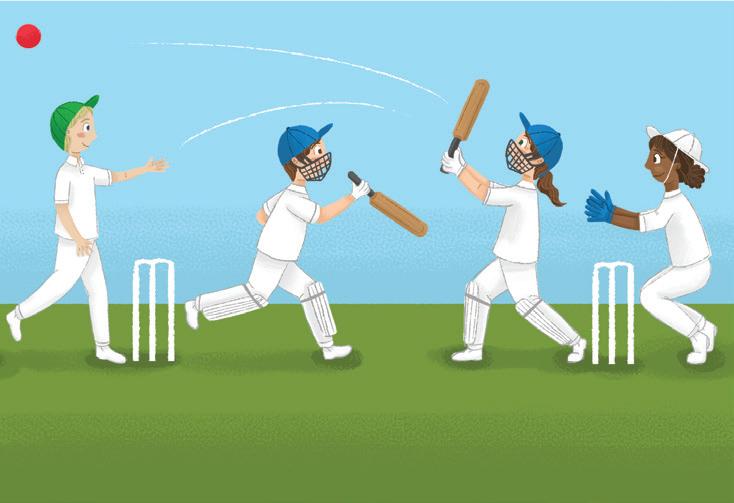
Create 4 different divisions that have a remainder of 2. 6 r2 r2 r2 r2 MP_NSW_SB6_38350_TXT_4PP.indb 11 25-Aug-23 17:54:22 SAMPLEPAGES

unit 11 PROBLEM SOLVING N Selects and applies appropriate strategies to solve multiplication and division problems 3 Revising 3-digit division/problems Oxford University Press Five-a-side cricket final Wombats Bull 86 Cooper 92 Dawlings 63 Dolderic 0 Fenton 14 Total Galahs Ferguson 50 Fong 51 Young 49 Halse 50 Jaworski 50 Total
5
Share out the hundreds with each school getting 1.
767 books were shared between 5 schools.
Mr Cook did a survey to find out how children most commonly use technology, then recorded the data in the form of a picture graph.
KEY = 10 children
Use the key to answer the questions.
a How many children answered Study?
b How many children answered Internet?
c How many children answered Messaging?
d How many more answered Internet than Study?
e What were the least common answers?
Technology use
Games Study Messaging Internet Email
Ms Zhang’s class did a survey to find out the most common eye colour of senior students. They made a table of the data. Eye colours
Colour Tally
Blue
Green
Brown Hazel
Create a picture graph using the given key.
= 4 children
Answer the questions.
a Which eye colour was the most common?
b Which eye colour was the least common?
c How many more children had blue eyes than brown eyes?
Blue Green Brown Hazel
Explain how you could make this survey more reflective of the whole population of people in NSW.
unit Oxford University Press 12
10
7 8 9
COMMUNICATING, REASONING Construct graphs using many-to-one scales Interpret data displays, including timelines and line graphs 3 Many to
scales/picture graphs MP_NSW_SB6_38350_TXT_4PP.indb 12 25-Aug-23 17:54:22
one
SAMPLEPAGES
Constructing angles
3
Use a protractor to construct the following acute, obtuse and right angles with the vertex on the left. •
acute angle 20°
vertex
obtuse angle 160°
acute angle 30°
obtuse angle 120°
right angle 90°
acute angle 25°
acute angle 60°
Use a protractor to construct the following angles with the vertex on the right. The first one has been done for you.
obtuse angle 170°
SAMPLEPAGES
acute angle 80°
acute angle 20°
obtuse angle 110°
obtuse angle 130°
right angle 90°
13 Measure and construct angles, and identify the relationships between angles on a straight line and angles at a point unit PROBLEM SOLVING, REASONING N L
Oxford University Press
11 12 MP_NSW_SB6_38350_TXT_4PP.indb 13 25-Aug-23 17:54:23
Addition/distance by car 4
Use the chart below to calculate the distance between airports and the total distance of each journey. The first one has been done for you. Round numbers to 100 and check your answers by estimating the distances.
Mark 2 flights on the map. Colour one blue and the other red. Calculate the total distance of each flight. 3 Blue flight Red flight
unit 14 PROBLEM SOLVING, COMMUNICATING, REASONING N L CCT Selects and applies appropriate strategies to solve addition and subtraction problems
Oxford University Press
NT SA VIC QLD NSW TAS WA PERTH ADELAIDE DARWIN MELBOURNE HOBART SYDNEY CANBERRA BRISBANE Mackay • Mt Isa • Alice Springs
Adelaide Alice Springs Brisbane Burnie (Wynyard) Cairns Canberra Darwin Devonport Gold Coast Gove Hamilton Island Hobart Launceston Mackay Melbourne Mt Isa Perth Proserpine Rockhampton Sydney Townsville Adelaide 1320 1622 1025 2779 970 2624 1054 1605 3271 2506 1260 1055 2416 650 1994 2118 2515 2136 1166 2731 Alice Springs 1320 1966 2236 1459 2258 1305 2276 2059 1952 1973 2478 2336 2065 1860 674 1977 2864 2486 2022 1426 Brisbane 1622 1966 1754 1391 951 2852 1788 93 2484 888 1788 1662 797 1381 1572 3806 898 518 752 1112 Burnie (Wynyard) 1025 2235 1754 3146 845 3542 61 1708 4237 2340 N/A N/A 2554 375 3326 3085 2652 2274 1081 2868 Cairns 2779 1459 1391 3146 2210 1677 2950 1485 1091 514 3299 3153 616 2679 785 3436 N/A 884 1974 285 Canberra 970 2258 951 845 2210 3392 879 916 3301 1764 1080 938 1783 470 2556 3180 1881 1504 237 1928 Darwin 2624 1305 2852 3542 1677 3392 3576 2945 647 2191 3788 3647 2347 3178 1297 2653 N/A 2627 3155 2021 Devonport 1054 2276 1788 61 2950 879 3576 1587 4183 2374 N/A N/A 2456 409 3360 3119 2686 2308 908 2902 Gold Coast 1605 2059 93 1708 1485 916 2945 1587 2576 983 1719 1595 893 1333 1665 3700 991 613 679 1207 Gove 3271 1952 2484 4237 1091 3301 647 4183 2576 1605 4384 4242 1707 3862 1944 3300 N/A 1987 3065 1376 Hamilton Island 2506 1973 888 2340 514 1764 2191 2374 983 1605 2575 2433 95 1965 2462 4807 N/A 372 1528 260 Hobart 1260 2478 1788 N/A 3299 1080 3788 N/A 1719 4384 2575 145 2793 610 3566 3320 2891 2514 1040 3107 Launceston 1055 2336 1662 N/A 3153 938 3647 N/A 1595 4242 2433 145 2651 468 3502 3178 2560 2372 916 2965 Mackay 2416 2065 797 2554 616 1783 2347 2456 893 1707 95 2793 2651 2163 2373 4589 N/A 280 1548 901 Melbourne 650 1860 1381 375 2679 470 3178 409 1333 3862 1965 610 468 2163 2644 2710 2273 1883 706 2493 Mt Isa 1994 674 1572 3326 785 2556 1297 3360 1665 1944 2462 3566 3502 2373 2644 2653 N/A 2092 2322 1070 Perth 2118 1977 3606 3085 3436 3180 2653 3119 3700 3300 4807 3320 3178 4589 2710 2653 4928 4310 3279 3721 Proserpine 2515 2864 898 2652 N/A 1881 N/A 2686 991 N/A N/A 2891 2560 N/A 2273 N/A 4928 382 1644 N/A Rockhampton 2136 2486 518 2274 884 1504 2627 2308 613 1987 372 2514 2372 280 1883 2092 4310 382 1177 N/A Sydney 1167 2022 752 1081 1974 237 3155 908 679 3065 1528 1040 916 1548 706 2322 3279 1644 1177 1692 Townsville 2731 1426 1112 2868 285 1928 2021 2902 1207 1376 260 3107 2965 901 2493 1070 3721 N/A N/A 1692 Flight Journey Distance Estimate a Darwin–Gove–Cairns 647 km + 1091 km = 1738 km 1700 b Brisbane–Melbourne–Hobart c Darwin–Alice Springs–Mt Isa d Adelaide–Canberra–Brisbane e Brisbane–Canberra–Melbourne f Hobart–Melbourne–Canberra g Gove–Cairns–Mackay 1 2 MP_NSW_SB6_38350_TXT_4PP.indb 14 25-Aug-23 17:54:23 SAMPLEPAGES
Kilometre chart
6
Write the numbers represented on each abacus. Don’t forget ‘0’ as a place holder.
Draw beads on the abacuses to represent the numbers.
Reading
When we read numbers, we read them in groups of hundreds, tens and ones. The following chart best illustrates this concept.
Note: A space separates the millions, thousands and ones when the number is larger than 9999.

Write the numbers on the place value grid before adding the correct spaces to the number. The first one has been done for you.
b 32451
c 736041
d 5425006
e 7325400
f 76245236
unit 15 Apply an understanding of place value and the role of zero to represent the properties of numbers
Oxford University Press
Place value 4
numbers
EXAMPLE Millions Thousands Ones Hund Tens Ones Hund Tens Ones Hund Tens Ones 206 341 2 0 6 3 4 1 257 403 280 2 5 7 4 0 3 2 8 0 H T O H T O Example 1 reads 2 0 6 thousand 3 4 1 ones H T O H T O H T O Example 2 reads 2 5 7 million 4 0 3 thousand 2 8 0 ones
a b c d HThou TenThou Thou Hund Tens Ones HThou TenThou Thou Hund Tens Ones HThou TenThou Thou Hund Tens Ones HThou TenThou Thou Hund Tens Ones
a 727 256 b 357 492 c 806 207 d 810 027 HThou TenThou Thou Hund Tens Ones HThou TenThou Thou Hund Tens Ones HThou TenThou Thou Hund Tens Ones HThou TenThou Thou Hund Tens Ones 4 5
Jumbled Millions Thousands Ones Spaced numbers Hund Tens Ones Hund Tens Ones Hund Tens Ones a 11234 1 1 2 3 4 11 234
MP_NSW_SB6_38350_TXT_4PP.indb 15 25-Aug-23 17:54:24
SAMPLEPAGES
Negative numbers
There are many instances in the real world where we need negative numbers. Negative numbers are numbers less than zero written with a minus sign (–) in front of them.

Estimate the distance between these points.
a The shipwreck and the octopus.
b The shipwreck and the hut.
Display how these problems can be calculated on a number line. The first one has been started for you.
=
Apply an understanding of place value and the role of zero to represent the properties of numbers

unit 16
PROBLEM SOLVING, UNDERSTANDING N CCT
Negative numbers 4
5 + 2 4 3 6
0 1 2 3 4 5 6 7 8 9 –1 –2 –3 –4 –5 –6 –7 –8 –9 b 0 + 4 + 3 9 + 2 = 0 1 2 3 4 5 6 7 8 9 –1 –2 –3 –4 –5 –6 –7 –8 –9 c 6 + 2 + 8 7 = 0 1 2 3 4 5 6 7 8 9 –1 –2 –3 –4 –5 –6 –7 –8 –9 8
a
9
800 m –800 m 600 m –600 m 400 m –400 m 200 m –200 m 0 Sea level Oxford University Press MP_NSW_SB6_38350_TXT_4PP.indb 16 25-Aug-23 17:54:25
SAMPLEPAGES
Classifying three-dimensional objects
Draw a line to match each net and three-dimensional object to its name.
Triangular pyramid
Hexagonal prism
Triangular prism
Rectangular prism
Square pyramid Cylinder
Classify the objects by stating the number of faces, edges and vertices on each.
Object Faces Edges Vertices
a Triangular pyramid
b Hexagonal prism
c Triangular prism
d Rectangular prism
SAMPLEPAGES
Vertex Edge Face
e Square pyramid
What am I?
a I am made from 4 triangles, which are the same shape, and a square. I also have 5 vertices, 5 faces and 8 edges.
b I am made from 2 identical pentagons and 5 identical rectangles. I also have 15 edges, 10 vertices and 7 faces.
1717
10 11 12 unit N CCT
Oxford University Press
4
Construct simple prisms and pyramids (ACMMG140) MP_NSW_SB6_38350_TXT_4PP.indb 17 25-Aug-23 17:54:25
Doing multiplication
• 3 × 5 = 15 Write 5 in the ones column and trade the 10 ones for 1 ten. Put 1 in the tens column.
• 3 × 3 tens equals 9 tens, plus 1 ten equals 10 tens. Trade the 10 tens for 1 hundred. Write the 0 in the tens column and a 1 in the hundreds column.
• 3 × 6 hundreds equals 18 hundreds, plus 1 hundred equals 19 hundreds. Write the 9 in the hundreds column and the 1 in the thousands.
Complete these algorithms.
Round to the nearest 10 or 100 to estimate each question, then answer them.

Solve the problems.
a 807 people attended a tennis match. If they all paid $8 each, how much money was collected? $
b Maria bought a new phone. How much did it cost her if she paid a $100 deposit and made 8 monthly payments of $129? $
11:30

unit 18 PROBLEM SOLVING N Selects and applies appropriate strategies to solve multiplication and division problems
Oxford University Press
5 Revising multiplication/estimation
Thous Hund Tens Ones 16 13 5 × 3 1 9 0 5
a 4 9 1 b 7 2 5 c 4 3 6 d 8 4 8 e 3 7 0 × 4 × 6 × 5 × 8 × 9 f 3 8 9 g 2 5 3 h 7 2 0 i 8 0 5 j 6 0 8 × 4 × 9 × 7 × 8 × 6 k 3 5 7 l 6 7 8 m 3 0 9 n 7 6 3 o 7 4 7 × 6 × 7 × 8 × 9 × 6
Algorithm Estimate Product Algorithm Estimate Product a 3 × 49 3 × 50 = 150 147 e 4 × 307 b 4 × 18 f 5 × 917 c 5 × 97 g 9 × 982 d 6 × 194 h 7 × 696
1
2 3
MP_NSW_SB6_38350_TXT_4PP.indb 18 25-Aug-23 17:54:26
SAMPLEPAGES
Decimals, percentages and fractions
Use your calculator to convert the fractions to decimals by dividing the numerator by the denominator. Once you have converted them to a decimal, write them as a percentage as well.
Write some fractions, then convert them to decimals then percentages with a calculator.
unit 19 COMMUNICATING L N Determine percentages of quantities, and find equivalent fractions and decimals for benchmark percentage values Compare and order decimals up to 3 decimal places 5
Oxford University Press
the charts to show equivalent fractions, decimals and percentages. 100 Common fraction Decimal % 100 Common fraction Decimal % a 55 100 0.55 55% g 100 10 or 5 b 100 h 100 10 or 5 c 100 i 100 10 or 5 d 100 1 2 0.5 50% j 100 10 or 5 e 100 4 k 100 4 f 100 10
Complete
Example: 1 4 = 1 ÷ 4 = 0.25 a 1 2 = 0.5 50% f 3 4 = 0. % k 3 10 = 0. % b 1 5 = 0. % g 27 100 = 0. % l 90 100 = 0. % c 1 20 = 0. % h 1 8 = 0. % m 5 10 = 0. % d 3 5 = 0. % i 7 10 = 0. % n 9 12 = 0. % e 4 8 = 0. % j 5 8 = 0. % o 3 8 = 0. % 4 5
6 MP_NSW_SB6_38350_TXT_4PP.indb 19 25-Aug-23 17:54:26 SAMPLEPAGES
Courtney has 5 cards with 2D shapes drawn on them. She is going to put them in a bag and will get her friend to pick one out.
Predict the probability of each shape card being selected as her first pick. Record each probability as a fraction.
Experiment
a Make a set of cards like the ones above.
b Place your cards in a bag and make 20 draws using all 5 cards each time.
c Use tally marks ( IIII ) to record your results.
Explain how your experiment results compare with your predictions in Question 7.
Jimmy has bought 100 lollies for his party. They only came in 4 colours. He put his hand in his bag and pulled out the following sample of 10 lollies.
R Y B R B B R P B P
Use the sample above to estimate how many lollies of each colour could be in the bag of 100 lollies.
a red b blue c pink d yellow
If there were a bag of 500 lollies and Jimmy pulled out the same 10 lollies, how many of each colour do you estimate could be in the bag?
a red b blue c pink d yellow
unit Oxford University Press 20
5 5 5 5 a b c d
7 8 10
11
5 Random selection/data sampling COMMUNICATING, REASONING N Conduct chance experiments and quantify the probability MP_NSW_SB6_38350_TXT_4PP.indb 20 25-Aug-23 17:54:26
9
SAMPLEPAGES
Estimating mass

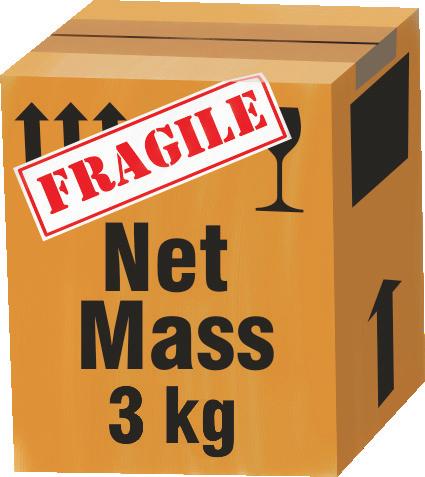
10 Estimate and then use calibrated scales or balance scales to measure the mass of each item. Estimate only one mass at a time.
h Did your estimates improve as you worked through the exercise?
11 Ten grams
Estimate first and then measure to see how many of each object are needed to balance 10 g.
How many of each item are needed to fill the boxes below?
21 Oxford University Press 21 unit Selects and uses the appropriate unit and device to measure the masses of objects N CCT
5
Item Estimate Mass a Glue stick
Scissors c Calculator
Pencil case
A watch
Stapler
b
d
e
f
g Ruler
Pencils Paperclips 5c coins Thumb tacks Centicubes Estimate Actual 12
a calculators e calculators b tape f tape c books g books d chocolates h chocolates 12 13 14 GLUE STICK GLUE STICK GLUE STICK GLUE STICK GLUE STICK GLUE STICK 1 ON OFF 2 3 0 + + =% C / 4 5 6 7 8 9 1 3 5 6 7 9 10 11 12 13 14 1 3 4 6 7 9 10 11 12 13 14 CATS BIG Chocolates Chocolates 600 g 750 g 500 g 150 g 10 1 ON OFF 2 3 0 + + =% C / 4 5 6 7 8 9 MP_NSW_SB6_38350_TXT_4PP.indb 21 25-Aug-23 17:54:28
SAMPLEPAGES
2673
Division strategies/problems
Trade the 1 hundred left over for 10 tens. Now share the 17 tens. Each paddock gets 3 tens. 5 2673 5 3 5 26 1 73 5 3 4r3 5 261723
Trade the 2 tens left over for 20 ones. Now share the 23 ones. Each paddock gets 4 ones. There is a remainder of 3.
a 5 | 2 6 5 5 b 6 | 3 7 8 6 c 4 | 2 7 2 8 d 4 | 3 9 6 4 e 6 | 4 0 2 6 f 5 | 2 7 5 4 g 6 | 2 7 7 7 h 6 | 2 9 2 6 i 5 | 3 7 7 5 j 4 | 2 6 7 5

a 5 9 3 r 3 | 4 7 4 7 b 5 3 0 r 4 | 4 7 7 4 c 4 4 2 r 6 | 3 5 4 2 d 6 3 2 r 3 | 3 7 9 5 e 4 3 3 r 1 | 3 0 3 2 Music
Island Railway
SAMPLEPAGES
e
Pop
Find a 4-digit number that can be divided by 2, 4 and 8, then complete the divisions. 4
MP_NSW_SB6_38350_TXT_4PP.indb 22 25-Aug-23 17:54:29

22 6 unit Oxford University Press
2 | 4 | 8 | PROBLEM SOLVING L N Selects and applies appropriate strategies to solve multiplication and division problems
Share 26 hundreds among 5. Each paddock gets hundreds.
Find the solutions.
Guess and then check to see what the missing divisors are in these divisions.
1 2 3
648 m 1238 m 442 m 256 m 834m 3024 m Motown Pop City Rock City Hip Hop Hollow Blues Point Rap Lake Jazz Heights
What is the average distance between railway stations for these trips? a Motown to Jazz Heights via Pop City m b Motown to Rock City via Blues Point and Hip Hop Hollow m c Jazz Heights to Motown via Rock City, Hip Hop Hollow and Blues Point m d
City to Hip Hop Hollow via Motown and Blues Point m
Motown to Motown in any direction m
sheep shared among
5 paddocks.
Note: Map is not drawn to scale.
Number patterns
Follow the instructions to answer the questions. This machine makes 20 milk cartons every minute.
Minutes 1 2 3 4 5 6 7 Cartons 20
This bath fills at a rate of 15 litres every minute.
a Complete the number pattern and record the rule.
b How many cartons would the machine make in 10 minutes?
Minutes 1 2 3 4 5 6 7 Litres 15
This car travels 13 km on every litre of petrol.
Litres 1 2 3 4 5 6 7 Kilometres 13
Radio station Double Z plays 12 songs every hour.
Hours 1 2 3 4 5 6 7 Songs 12
6 7
Number pattern
a Find the pattern in the table below, then complete it.
First number 1 2 3 4 5 6 7
Second number 18 45 63
b Describe the relationship between the first number and the second number.
c What would be the 10th term in the pattern?
c Complete the number pattern and record the rule.
d How many litres would be in the bath after 12 minutes?
e Complete the number pattern and record the rule.
f How far would the car travel on 15 L of petrol?
g Complete the number pattern and record the rule.
h How many songs would be played in 12 hours?
Number pattern.
SAMPLEPAGES
a Find the pattern in the table below, then complete it.
First number 11 12 13 14 15 16 17
Second number 24 26 29
b Describe the relationship between the first number and the second number.
c What would be the 10th term in the pattern?
23 6 unit COMMUNICATING, REASONING N CCT Oxford University Press
5
Construct and complete number sentences involving multiplicative relations, applying the order of operations to calculations MP_NSW_SB6_38350_TXT_4PP.indb 23 25-Aug-23 17:54:30
Side-by-side column graphs
The Walters family is leaving soon on a world trip. They need to know what clothes to take, so they are looking very carefully at the temperatures of the cities they will visit.
Cities of the world: temperatures
Answer these questions.
a Which city has the highest maximum temperature?
b Which city has the lowest maximum temperature?
c Which city has the highest minimum temperature?
d Which city has the lowest minimum temperature?
e How many degrees hotter is Bangkok than Athens?
f How many degrees hotter is Athens than New York?
g Which city has the greatest difference in minimum and maximum temperatures?
h Which city has the smallest difference in minimum and maximum temperatures?
What is the difference between the minimum and maximum temperatures of these cities?
SAMPLEPAGES
What is the average maximum temperature of Melbourne, Sydney and Darwin?
Which minimum temperature appears most often?
Which maximum temperature appears most often?
24 unit 6 L N Oxford University Press
Interpret data displays, including timelines and line graphs
Constructs graphs using many-to-one scales
Melbourne Sydney Darwin Bangkok Athens
London New York
Temperature °C minimum temperature Cities maximum temperature 32 28 24 20 16 12 8 4
Tokyo Beijing
a
c
e
d
f
Sydney
Bangkok
London b Melbourne
Athens
Beijing
8 9 10 11 12 MP_NSW_SB6_38350_TXT_4PP.indb 24 25-Aug-23 17:54:30
Complete the clockfaces for each digital time. The first one is done for you.
SAMPLEPAGES

I think 30 days is equal to 720 hours.

facts: 60 seconds = 1 minute 7 days = 1 week 365 days = 1 year 60 minutes = 1 hour 14 days = 1 fortnight 366 days = 1 leap year 24 hours = 1 day 52 weeks = 1 year 12 months = 1 year Oxford University Press 25 unit 6 L Measure and compare duration, using 12- and 24-hour time and am and pm notation am and pm revision
a 5
i 2
j 3
10
k 5 1 2
=
d 4
l 30
=
e 5 1 4
=
m 2 1 2
=
n 49 days =
g
o 75
=
h 360 seconds =
p 4 1 2 years =
15
Time
Convert these time facts to another unit.
minutes = seconds
days = hours b 3 minutes = seconds
days = hours c
minutes = seconds
days
hours
1 2 hours = minutes
minutes
seconds
hours
minutes
minutes
seconds f 24 hours = minutes
weeks
35 days = weeks
minutes
seconds
minutes
weeks
a 3:15 pm b 1:40 pm c 2:22 am d 12:34 pm 11 12 1 2 3 4 5 6 7 8 9 10 11 12 1 2 3 4 5 6 7 8 9 10 11 12 1 2 3 4 5 6 7 8 9 10 11 12 1 2 3 4 5 6 7 8 9 10 e 4:05 pm f 9:52 am g 9:43 pm h 1:01 pm 11 12 1 2 3 4 5 6 7 8 9 10 11 12 1 2 3 4 5 6 7 8 9 10 11 12 1 2 3 4 5 6 7 8 9 10 11 12 1 2 3 4 5 6 7 8 9 10 i 10:45 am j 7:52 pm k 8:07 pm l 11:15 am 11 12 1 2 3 4 5 6 7 8 9 10 11 12 1 2 3 4 5 6 7 8 9 10 11 12 1 2 3 4 5 6 7 8 9 10 11 12 1 2 3 4 5 6 7 8 9 10
the time
11 12 1 2 3 4 5 6 7 8 9 10 11 12 1 2 3 4 5 6 7 8 9 10 11 12 1 2 3 4 5 6 7 8 9 10 11 12 1 2 3 4 5 6 7 8 9 10 + 25 min + 1 hr 10 min + 1 hr 17 min 13 14
Complete
trail.
MP_NSW_SB6_38350_TXT_4PP.indb 25 25-Aug-23 17:54:31
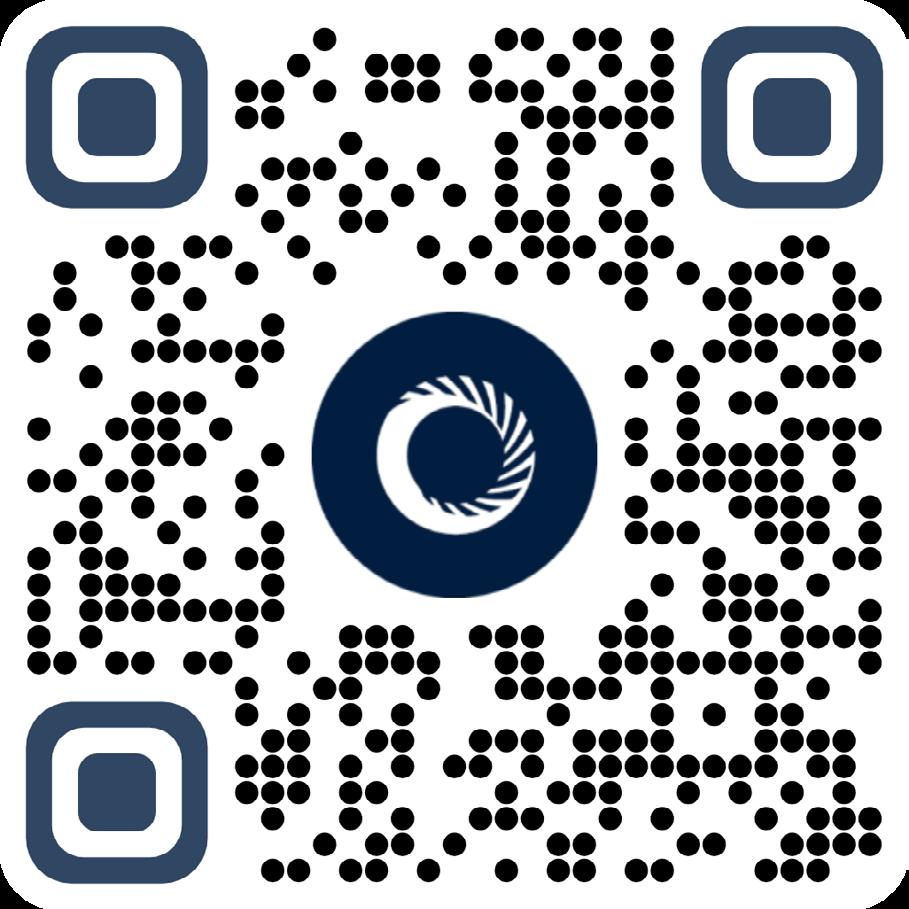
To access the full digital sample of this book simply scan the QR code: 12 6 93 1 11 10 8 75 4 2 oup.com.au oxford-university-press-australia-new-zealand @OxfordAustraliaNZ facebook.com/oupanz Contact your local education consultant Visit oup.com.au/contact Customer Support ANZ Customer Help Centre: oup.com.au/help Free Tel: 1300 650 616 Free Fax: 1800 813 602 Oxford University Press GPO Box 2784 MELBOURNE VIC 3001 ARBN: 007 510 125 ABN: 29 869 163 236 For more information visit oup.com.au/primary/mathematics/maths-plus-NSW










































